warning JEEP WRANGLER 2010 Owner's Guide
[x] Cancel search | Manufacturer: JEEP, Model Year: 2010, Model line: WRANGLER, Model: JEEP WRANGLER 2010Pages: 554, PDF Size: 10.16 MB
Page 433 of 554

WARNING!
•Do not connect trailer brakes to your vehicle’s
hydraulic brake lines. It can overload your brake
system and cause it to fail. You might not have
brakes when you need them and could have an
accident.
•Towing any trailer will increase your stopping
distance. When towing, you should allow for ad-
ditional space between your vehicle and the ve-
hicle in front of you. Failure to do so could result
in an accident.
Towing Requirements – Trailer Lights and Wiring
Whenever you pull a trailer, regardless of the trailer size,
stop lights and turn signals on the trailer are required for
motoring safety.The Trailer Tow Package will include a four–pin wiring
harness. Use a factory-approved trailer harness and
connector.
NOTE:
Do not cut or splice wiring into the vehicles
wiring harness.
The electrical connections are all complete to the vehicle
but you must mate the harness to a trailer connector.
Refer to the following illustration.
432 STARTING AND OPERATING
Page 441 of 554
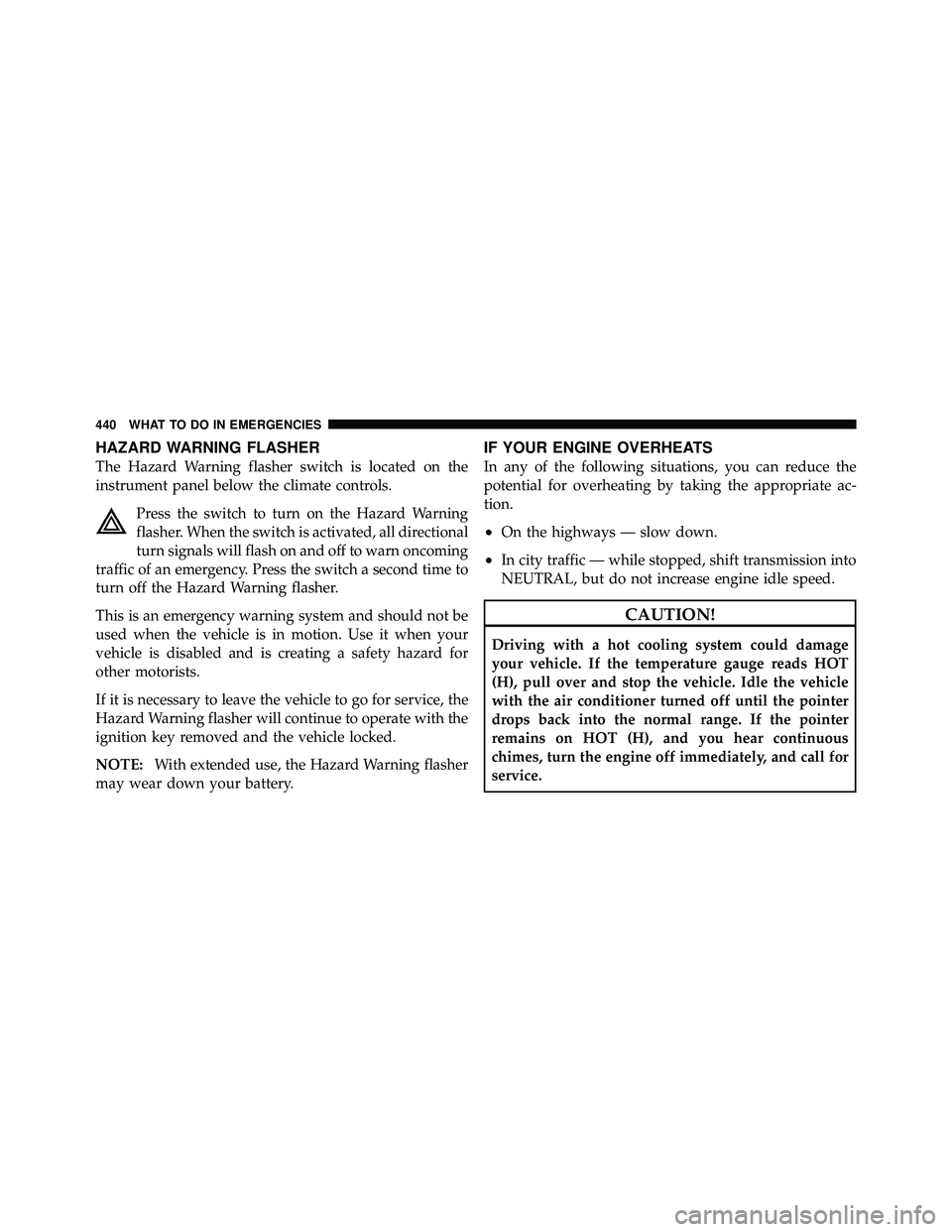
HAZARD WARNING FLASHER
The Hazard Warning flasher switch is located on the
instrument panel below the climate controls.Press the switch to turn on the Hazard Warning
flasher. When the switch is activated, all directional
turn signals will flash on and off to warn oncoming
traffic of an emergency. Press the switch a second time to
turn off the Hazard Warning flasher.
This is an emergency warning system and should not be
used when the vehicle is in motion. Use it when your
vehicle is disabled and is creating a safety hazard for
other motorists.
If it is necessary to leave the vehicle to go for service, the
Hazard Warning flasher will continue to operate with the
ignition key removed and the vehicle locked.
NOTE: With extended use, the Hazard Warning flasher
may wear down your battery.
IF YOUR ENGINE OVERHEATS
In any of the following situations, you can reduce the
potential for overheating by taking the appropriate ac-
tion.
•On the highways — slow down.
•In city traffic — while stopped, shift transmission into
NEUTRAL, but do not increase engine idle speed.
Page 447 of 554
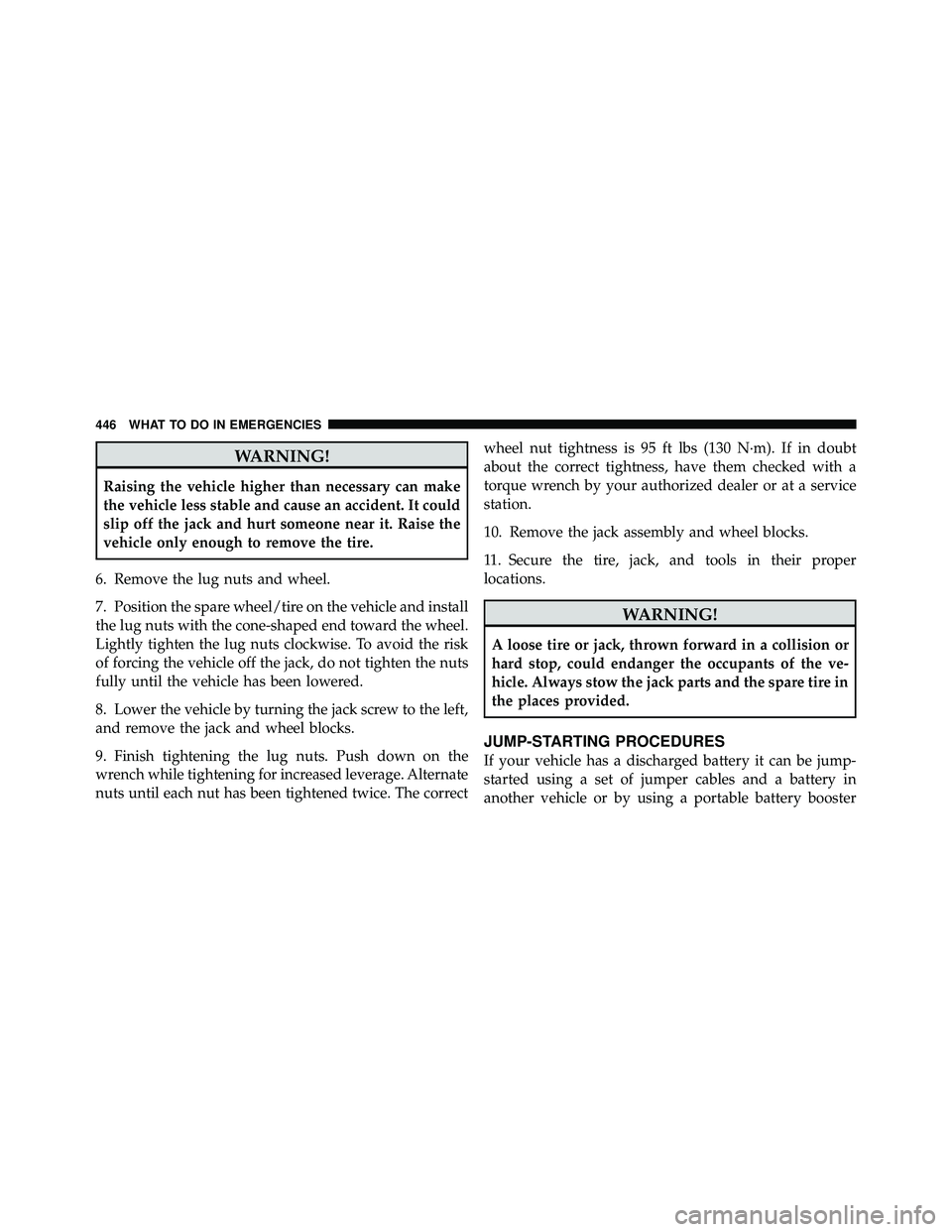
WARNING!
Raising the vehicle higher than necessary can make
the vehicle less stable and cause an accident. It could
slip off the jack and hurt someone near it. Raise the
vehicle only enough to remove the tire.
6. Remove the lug nuts and wheel.
7. Position the spare wheel/tire on the vehicle and install
the lug nuts with the cone-shaped end toward the wheel.
Lightly tighten the lug nuts clockwise. To avoid the risk
of forcing the vehicle off the jack, do not tighten the nuts
fully until the vehicle has been lowered.
8. Lower the vehicle by turning the jack screw to the left,
and remove the jack and wheel blocks.
9. Finish tightening the lug nuts. Push down on the
wrench while tightening for increased leverage. Alternate
nuts until each nut has been tightened twice. The correct wheel nut tightness is 95 ft lbs (130 N·m). If in doubt
about the correct tightness, have them checked with a
torque wrench by your authorized dealer or at a service
station.
10. Remove the jack assembly and wheel blocks.
11. Secure the tire, jack, and tools in their proper
locations.
Page 449 of 554
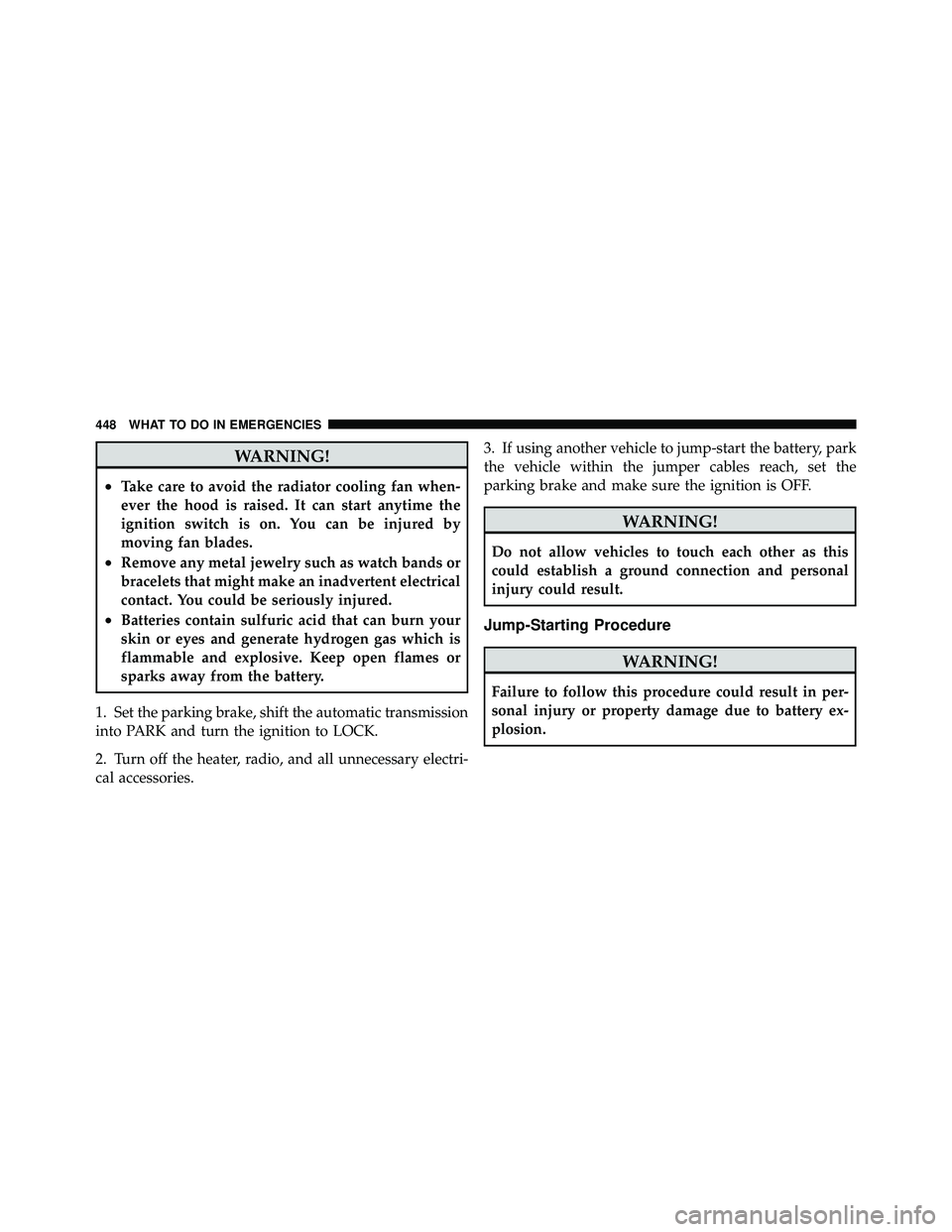
WARNING!
•Take care to avoid the radiator cooling fan when-
ever the hood is raised. It can start anytime the
ignition switch is on. You can be injured by
moving fan blades.
•Remove any metal jewelry such as watch bands or
bracelets that might make an inadvertent electrical
contact. You could be seriously injured.
•Batteries contain sulfuric acid that can burn your
skin or eyes and generate hydrogen gas which is
flammable and explosive. Keep open flames or
sparks away from the battery.
1. Set the parking brake, shift the automatic transmission
into PARK and turn the ignition to LOCK.
2. Turn off the heater, radio, and all unnecessary electri-
cal accessories. 3. If using another vehicle to jump-start the battery, park
the vehicle within the jumper cables reach, set the
parking brake and make sure the ignition is OFF.
Page 465 of 554

WARNING!
•Battery fluid is a corrosive acid solution and can
burn or even blind you. Do not allow battery fluid
to contact your eyes, skin, or clothing. Do not lean
over a battery when attaching clamps. If acid
splashes in eyes or on skin, flush the area imme-
diately with large amounts of water. Refer to
“Jump-Starting Procedures” in “What To Do In
Emergencies” for further information.
•Battery gas is flammable and explosive. Keep
flame or sparks away from the battery. Do not use
a booster battery or any other booster source with
an output greater than 12 Volts. Do not allow cable
clamps to touch each other.
•Battery posts, terminals, and related accessories
contain lead and lead compounds. Wash hands
after handling.
Page 475 of 554
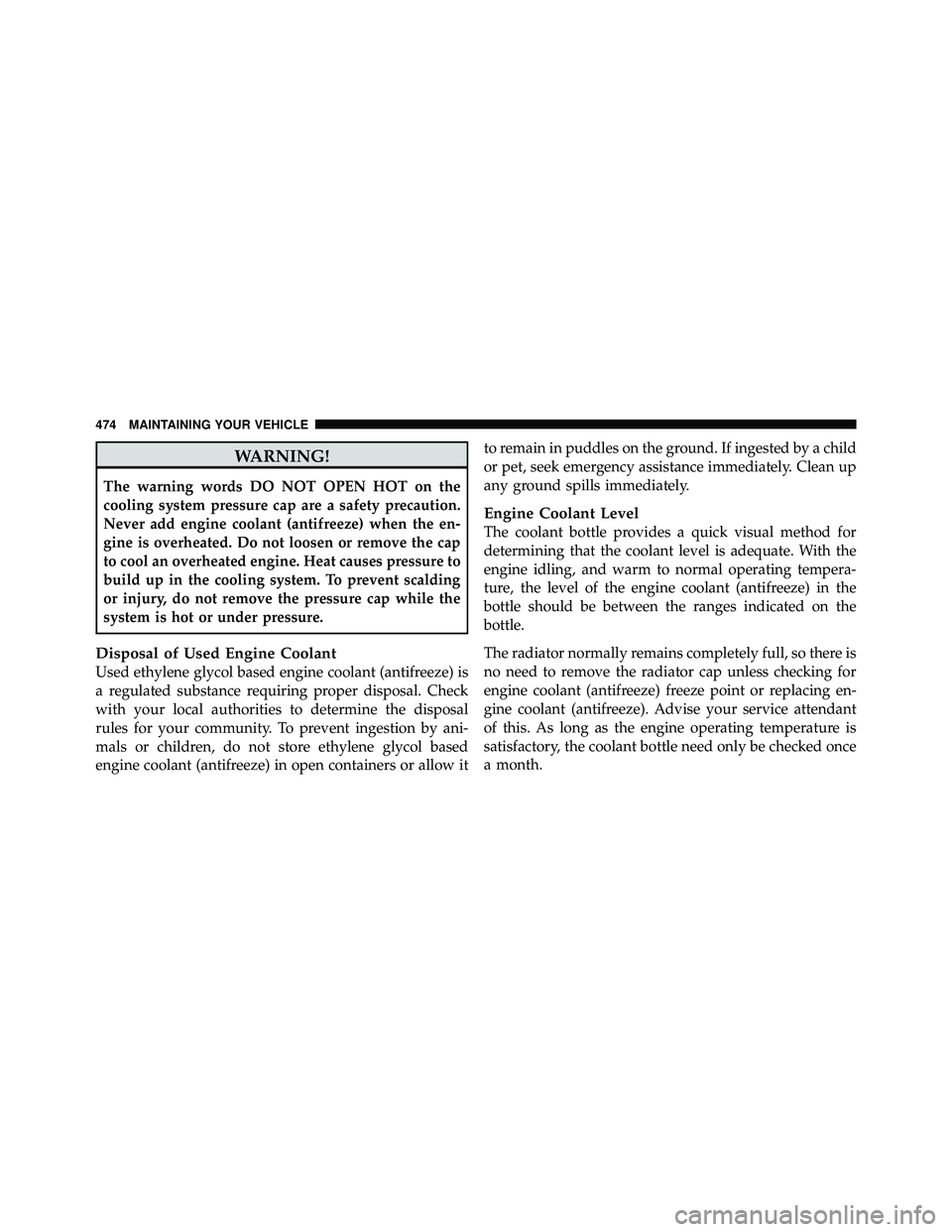
WARNING!
The warning words DO NOT OPEN HOT on the
cooling system pressure cap are a safety precaution.
Never add engine coolant (antifreeze) when the en-
gine is overheated. Do not loosen or remove the cap
to cool an overheated engine. Heat causes pressure to
build up in the cooling system. To prevent scalding
or injury, do not remove the pressure cap while the
system is hot or under pressure.
Disposal of Used Engine Coolant
Used ethylene glycol based engine coolant (antifreeze) is
a regulated substance requiring proper disposal. Check
with your local authorities to determine the disposal
rules for your community. To prevent ingestion by ani-
mals or children, do not store ethylene glycol based
engine coolant (antifreeze) in open containers or allow itto remain in puddles on the ground. If ingested by a child
or pet, seek emergency assistance immediately. Clean up
any ground spills immediately.
Engine Coolant Level
The coolant bottle provides a quick visual method for
determining that the coolant level is adequate. With the
engine idling, and warm to normal operating tempera-
ture, the level of the engine coolant (antifreeze) in the
bottle should be between the ranges indicated on the
bottle.
The radiator normally remains completely full, so there is
no need to remove the radiator cap unless checking for
engine coolant (antifreeze) freeze point or replacing en-
gine coolant (antifreeze). Advise your service attendant
of this. As long as the engine operating temperature is
satisfactory, the coolant bottle need only be checked once
a month.
474 MAINTAINING YOUR VEHICLE
Page 479 of 554
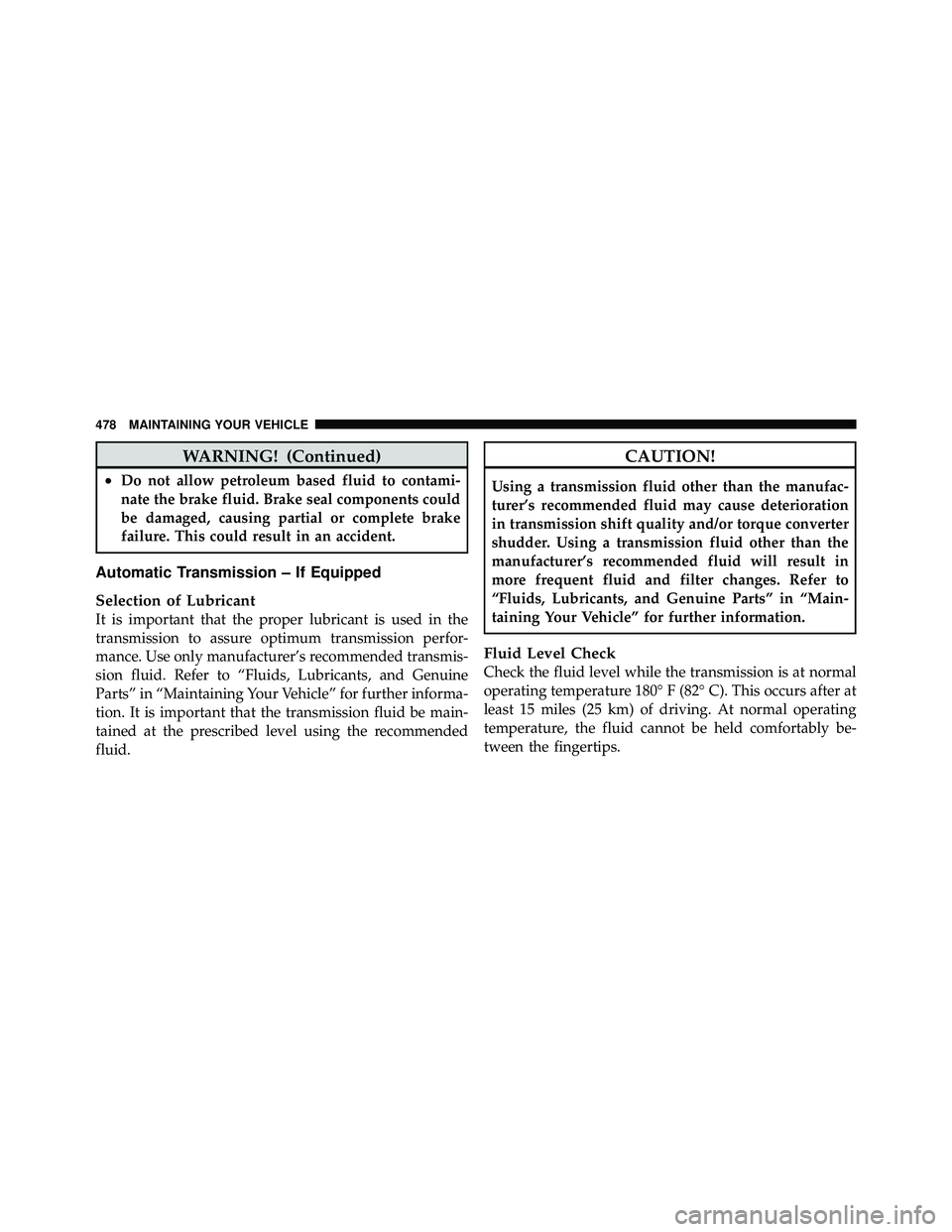
WARNING! (Continued)
•Do not allow petroleum based fluid to contami-
nate the brake fluid. Brake seal components could
be damaged, causing partial or complete brake
failure. This could result in an accident.
Automatic Transmission – If Equipped
Selection of Lubricant
It is important that the proper lubricant is used in the
transmission to assure optimum transmission perfor-
mance. Use only manufacturer’s recommended transmis-
sion fluid. Refer to “Fluids, Lubricants, and Genuine
Parts” in “Maintaining Your Vehicle” for further informa-
tion. It is important that the transmission fluid be main-
tained at the prescribed level using the recommended
fluid.
Page 535 of 554
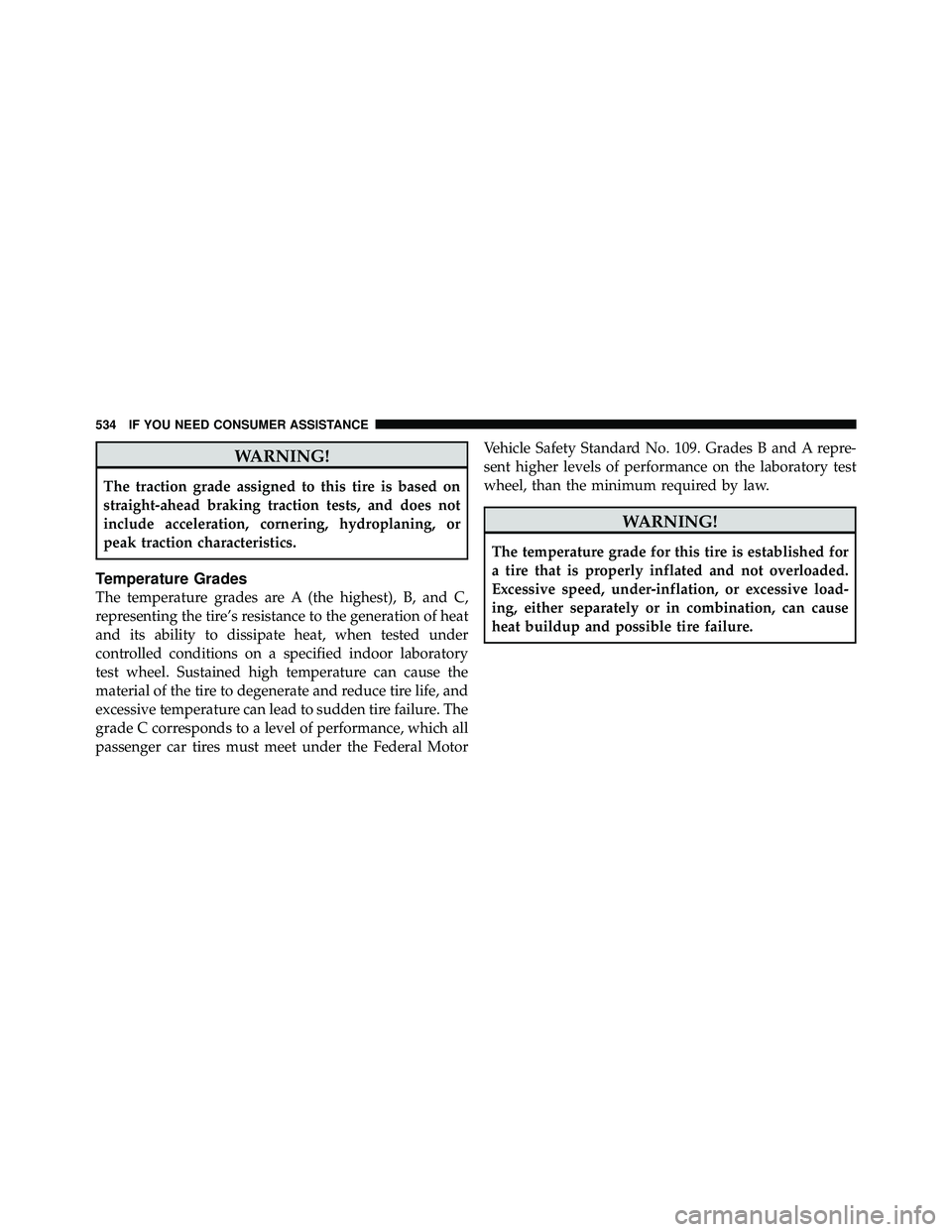
WARNING!
The traction grade assigned to this tire is based on
straight-ahead braking traction tests, and does not
include acceleration, cornering, hydroplaning, or
peak traction characteristics.
Temperature Grades
The temperature grades are A (the highest), B, and C,
representing the tire’s resistance to the generation of heat
and its ability to dissipate heat, when tested under
controlled conditions on a specified indoor laboratory
test wheel. Sustained high temperature can cause the
material of the tire to degenerate and reduce tire life, and
excessive temperature can lead to sudden tire failure. The
grade C corresponds to a level of performance, which all
passenger car tires must meet under the Federal MotorVehicle Safety Standard No. 109. Grades B and A repre-
sent higher levels of performance on the laboratory test
wheel, than the minimum required by law.
Page 537 of 554
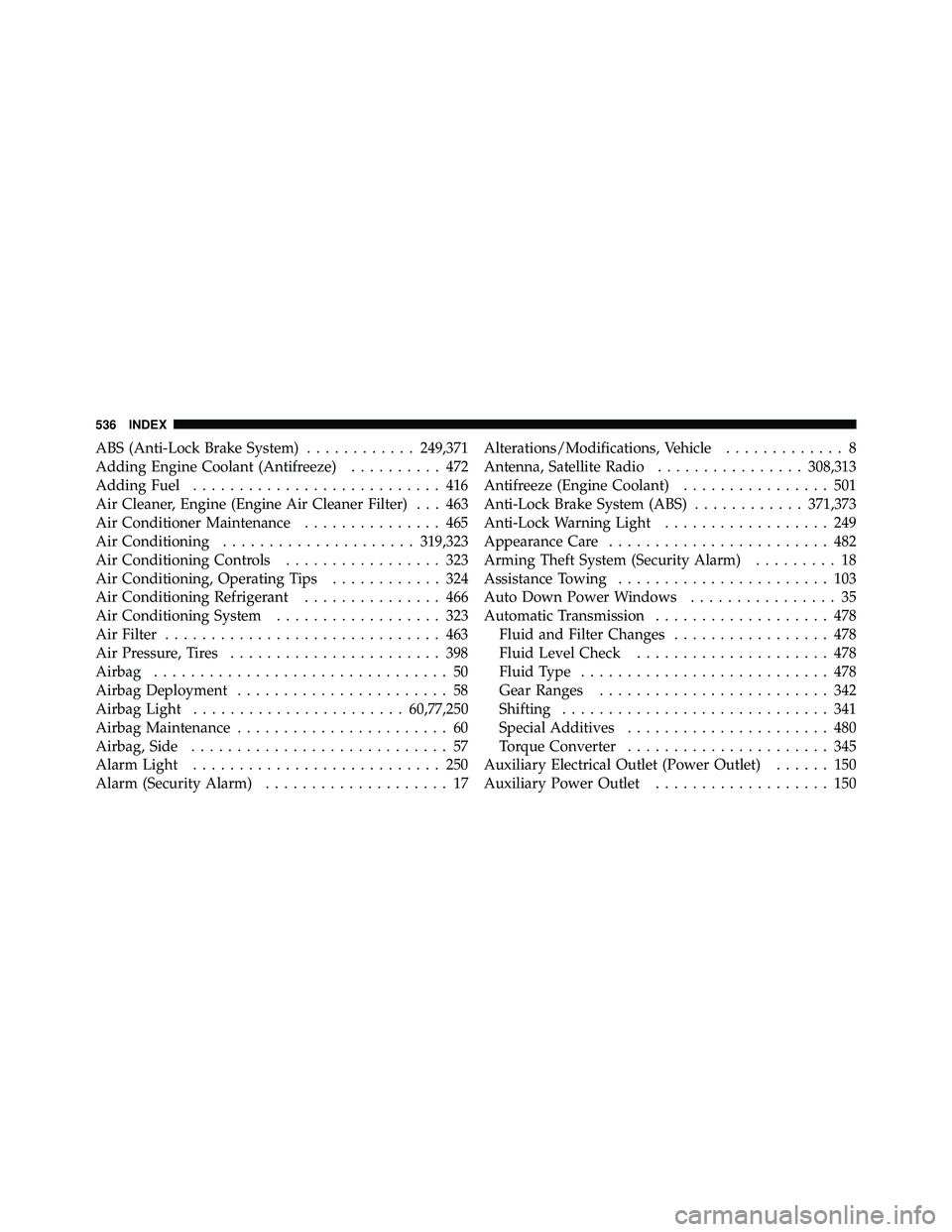
ABS (Anti-Lock Brake System)............249,371
Adding Engine Coolant (Antifreeze) .......... 472
Adding Fuel ........................... 416
Air Cleaner, Engine (Engine Air Cleaner Filter) . . . 463
Air Conditioner Maintenance ............... 465
Air Conditioning ..................... 319,323
Air Conditioning Controls ................. 323
Air Conditioning, Operating Tips ............ 324
Air Conditioning Refrigerant ............... 466
Air Conditioning System .................. 323
Air Filter .............................. 463
Air Pressure, Tires ....................... 398
Airbag ................................ 50
Airbag Deployment ....................... 58
Airbag Light ....................... 60,77,250
Airbag Maintenance ....................... 60
Airbag, Side ............................ 57
Alarm Light ........................... 250
Alarm (Security Alarm) .................... 17 Alterations/Modifications, Vehicle
............. 8
Antenna, Satellite Radio ................308,313
Antifreeze (Engine Coolant) ................ 501
Anti-Lock Brake System (ABS) ............371,373
Anti-Lock Warning Light .................. 249
Appearance Care ........................ 482
Arming Theft System (Security Alarm) ......... 18
Assistance Towing ....................... 103
Auto Down Power Windows ................ 35
Automatic Transmission ................... 478
Fluid and Filter Changes ................. 478
Fluid Level Check ..................... 478
Fluid Type ........................... 478
Gear Ranges ......................... 342
Shifting ............................. 341
Special Additives ...................... 480
Torque Converter ...................... 345
Auxiliary Electrical Outlet (Power Outlet) ...... 150
Auxiliary Power Outlet ................... 150
536 INDEX
Page 541 of 554

Flooded, Starting...................... 332
Fuel Requirements .................. 41 1,501
Jump Starting ......................... 446
Oil .............................. 460,501
Oil Disposal .......................... 462
Oil Filter ............................ 462
Oil Selection .......................... 501
Overheating .......................... 440
Starting ............................. 331
Temperature Gauge .................... 251
Engine Oil Viscosity ...................... 462
Engine Oil Viscosity Chart ................. 462
Enhanced Accident Response Feature .......... 58
Entry System, Illuminated .................. 19
Event Data Recorder ...................... 60
Exhaust Gas Caution ................... 76,415
Exhaust System ....................... 76,468
Extender, Seat Belt ........................ 49
Exterior Finish Care ...................... 483 Exterior Lights
.......................... 79
Fabric Care ......................... 485,487
Fabric Top ............................. 487
Filters Air Cleaner .......................... 463
Engine Oil ........................... 462
Finish Care ............................ 483
Flashers Hazard Warning ....................... 440
Turn Signal ................... 79,247,499,500
Flooded Engine Starting ................... 332
Fluid Capacities ......................... 501
Fluid Leaks ............................. 79
Fluid Level Checks ...................... 482
Automatic Transmission ................. 478
Engine Oil ........................... 460
Manual Transmission ................... 481
Power Steering ........................ 368
540 INDEX